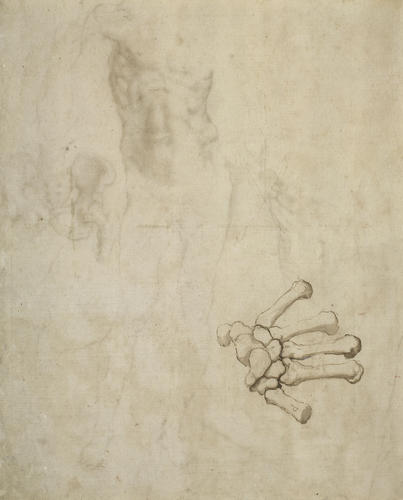-
1 of 253523 objects
Studies of a male nude, and the bones of the hips c.1505-20
Pen and ink; with wash on the verso. Watermark of crossed arrows and star. | 33.3 x 26.7 cm (sheet of paper) | RCIN 990433

Copy after Michelangelo Buonarroti (Caprese 1475-Rome 1564)
Studies of a male nude, and the bones of the hips c.1505-20

Copy after Michelangelo Buonarroti (Caprese 1475-Rome 1564)
Studies of a male nude, and the bones of the hips c.1505-20


-
Studies in pen and ink drawing of a male nude, the pelvic bones and, below, a seated child. On the verso, the bones of a hand.
The recto of the sheet probably records a lost original by Michelangelo, though the draughtsman has employed a finer pen that is found in Michelangelo’s drawings and has interpreted rather than followed his hatching system. The effect is to diminish Michelangelo’s vigour and ruggedness, and to accentuate his elegance.
The main study is related to Michelangelo’s drawing of a standing male nude in the Louvre (inv. RF1068v), of c.1505-6. Although very similar to that figure, this is not a copy of it: there are significant differences in the position of the legs and the rhythm of the torso, and the head is here excluded. The main drawing must instead be a copy of a lost variant study for the same figure as the Louvre drawing. Since the figure in the Louvre drawing is close in pose to another figure found on a further pen drawing in the Louvre (inv. 688), the so-called Mercury-Apollo, it is possible that Michelangelo, in both of the Louvre drawings and in the lost original of the present drawing, was experimenting with Mercury’s pose. The purpose of the Mercury is unknown, but it is more likely to have been sculptural than pictorial. The Tomb of Pope Julius II, in its first free-standing version of 1505, was to have been placed between two banks of choir stalls in Old St Peter’s and was to feature large figurative reliefs on each flank. There is no record of what those reliefs might have been, but given the context, scenes with a musical content are a strong possibility, in which case Mercury’s invention of the lyre would have made an appropriate, if pagan, theme. Another copy of a contemporary lost drawing (Louvre 18368) depicts a nude figure playing a tambourine.
The subsidiary figure on the left is a variant of the main figure, with narrower waist and legs placed closer together; it is close to a figure on Louvre 688v (the recto cited above).
The pen drawing of the pelvic girdle is not paralleled among Michelangelo’s surviving works, but it is related to the pose of the main figure, and would have been an unusual addition for a copyist to have made. The structure of the lower pelvis is misrepresented (and spatially ambiguous), suggesting that the drawing is a poorly comprehended copy of a more accurate original.
The sketch of the child at lower left is plausibly a copy of a lost drawing by Michelangelo, with a similar pose to the Christ Child in Michelangelo’s Virgin and Child with St Anne in the Louvre (inv. 685), again c.1505-6.
On the verso of the sheet it a drawing of the bones of the hand (the carpals and metacarpals only), in a style not usually associated with Michelangelo, who very rarely used wash in conjunction with pen outlines. But so few studies of bones by the artist survive that it is difficult either to accept or reject it as a copy of a lost original.
Text adapted from P. Joannides, Michelangelo and his Influence, 1996, no. 28.Provenance
Listed in George III's 'Inventory A,' c.1800, p.44, 'Mich: Angelo Buonarroti', Tom. I: '32. A drawing of part of a Body; and Hip-Bone.'
-
Creator(s)
-
Medium and techniques
Pen and ink; with wash on the verso. Watermark of crossed arrows and star.
Measurements
33.3 x 26.7 cm (sheet of paper)
Markings
watermark:
Crossed arrows with star (not in Briquet)
Other number(s)
RL O : Royal Library "O" Number Register – RL O433Alternative title(s)
Verso: The bones of the hand